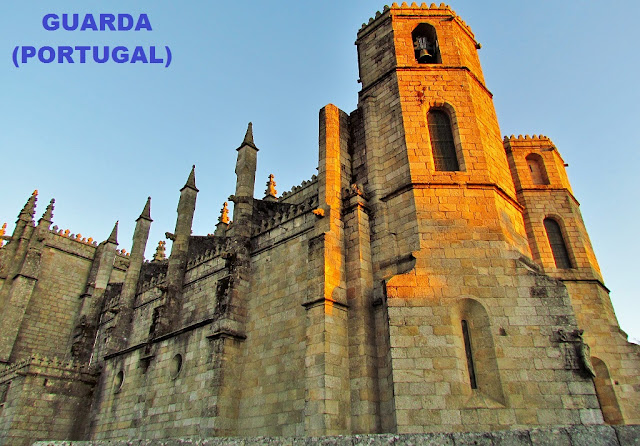GUARDA
N 40º 32' 10''; W 7º16' 36''
Guarda is a Portuguese city. With 1,056 meters of maximum altitude, it is the highest city in the country. With 26 565 inhabitants in its urban perimeter, the capital of the district of Guarda, located in the statistical region of the Center and sub-region of Beiras and Serra da Estrela. It is the seat of a municipality with 712.1 km² of area and 42 541 inhabitants (2011 censuses), subdivided since the administrative reorganization of 2012/2013 in 43 parishes. The municipality is limited to the northeast by the municipality of Pinhel, to the east by Almeida, to the southeast by Sabugal, to the south by Belmonte and Covilhã, to the west by Manteigas and Gouveia, and to the northwest by Celorico da Beira. Its district has a resident population of 173 831 inhabitants. It is located on the last northeast buttress of Serra da Estrela.
It has important road accesses, such as the A25, which connects it to Aveiro and Porto, as well as to the border, giving a direct connection to Madrid; the A23, which connects Guarda to Lisbon and the South of Portugal, as well as the IP2, which connects Guarda to Trás-os-Montes and Alto Douro, namely Bragança.
The air, historically recognized for its healthiness and purity, was distinguished by the European Bioclimatism Federation in 2002.
The whole region is marked by granite, the contrasted mountain climate, and its pure and cold air that allows the curing and manufacture of very high quality smoked and cheese making. It is also from this region that the subsidiary water lines of the largest hydrographic basins that supply the three largest cities in Portugal pour: to the Tagus basin that supplies Lisbon, to the Mondego basin that supplies Coimbra, and to the Douro basin that supplies Porto. There is even a pattern in the town of Vale de Estrela (6 km from the city of Guarda) that marks the triple point where the three hydrographic basins meet.
Guarda is overlooking the Mondego Valley, inserted in the last buttress North of Serra da Estrela is the highest city in Portugal, regarding the altitude of the urban area of the municipality, with a maximum altitude of 1,056 meters.
The climate in the city of Guarda is temperate, with a Mediterranean influence, since in summer there is a short dry season. The hottest month is July, with an average temperature of 19.7 ° C, and the coldest month is January, with an average of 4 ° C. The wettest month is December, with an average rainfall of 150.6 mm, and the driest month is August, with an average of just 10.4 mm. The average annual temperature is 11.1 ° C and the average annual rainfall is 914.2 mm. It is considered one of the coldest cities in Portugal, experiencing snow precipitation a few times a year.
The good geographical location of the municipality and good accessibility make Guarda an excellent place for the storage and transport of goods from Portugal to the rest of Europe (and vice versa), in this sense private entities together with the City Council created the Platform Business Initiative Logistics (PLIE), which is a cross-border platform that seeks to boost the regional economy and attract industrial flows and investments.
Currently, the municipality has several hotels that take advantage of the proximity to the Serra da Estrela, the Historical Villages, and the Douro wine region which position Guarda as an ideal base for discovering these destinations.
💓💓💓💓💓
SEARCH IN ALPHABETICAL ORDER
IN THE DISTRICT OF GUARDA

Aguiar da Beira;
Almeida;
Almendra;
Castelo Bom;
Castelo Melhor;
Castelo Rodrigo;
Celorico da Beira;
Figueira de Castelo Rodrigo;
Fornos de Algodres;
Freixo de Numão;
Golfar + A-do-Cavalo;
Almeida;
Almendra;
Castelo Bom;
Castelo Melhor;
Castelo Rodrigo;
Celorico da Beira;
Figueira de Castelo Rodrigo;
Fornos de Algodres;
Freixo de Numão;
Golfar + A-do-Cavalo;
Moreira de Rei (Trancoso);
Numão;
Pinhel;
Ranhados;
Sabugal;
Seia;
Serra da Estrela Nature Park;
Sortelha;
Trancoso;
Valhelhas;
Vila Nova de Foz Côa;
Vilar Formoso;
Numão;
Pinhel;
Ranhados;
Sabugal;
Seia;
Serra da Estrela Nature Park;
Sortelha;
Trancoso;
Valhelhas;
Vila Nova de Foz Côa;
Vilar Formoso;
💓💓💓💓💓
Return to mainland Portugal &
the Azores and Madeira islands





































































































